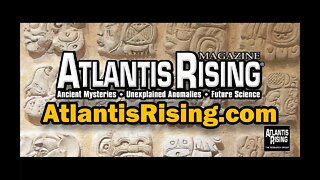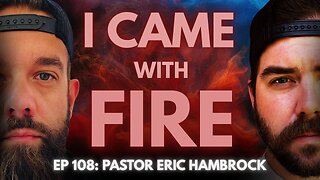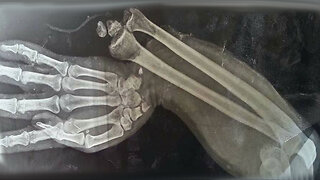Premium Only Content

Nazi Plunder Comes to Light? - Atlantis Rising Research Group
Visit Atlantis Rising Research Group at https://www.atlantisrising.com/
According to May press reports, billions of dollars’ worth of lost Nazi loot may have been located.
Though greeted with skepticism by some experts, the story does include sensational details that—even in a time of pandemic, economic crises, and social turmoil—have excited media around the world.
At the end of WWII, the Nazis are purported to have hidden an estimated 28 tons of gold, stolen art, and other treasures in numerous secret locations. The details appear in the meticulous diary of an anonymous Waffen SS officer writing under the pseudonym ‘Michaelis.’ One site already renowned for WWII treasure, the Hochberg Palace in Roztoka, near Wałbrzych, Poland, is thought to be hiding an enormous cache, almost 200 feet below ground at the bottom of an ancient and disused well.
Many of the lost treasures, reportedly, were secreted shortly before the war’s end by Gunther Grundmann, German heritage conservator of Lower Silesia. Working under the direction of Hitler henchman Heinrich Himmler, Grundmann was trying to hide all Nazi-held treasure from the rapidly advancing, and much feared, Red army.
‘Michaelis,’ the diary’s author, worked for Grundmann. According to TheFirstNews.com, a prominent Polish news organization, the diary had been held since the war by a mysterious thousandyear- old German secret society in the small town of Quedlinburg in Saxony-Anhalt.
It has now been offered to the Polish nation as a gesture of atonement for the war. In the 1930s and ’40s, Quedlinburg was the scene of Nazi cult worship, but unlike the latter-day—and overtly political—Thule society that gave rise to the Nazi party, the history of the Quedlinburgers goes back to the early 10th century.
While many academic authorities dismiss as fanciful the suggestions that dark metaphysics could have been central to Nazi thinking, some believe hard evidence may yet emerge, and the Quedlinburg diary may help to fill the blanks. Most theories about occult influence on the Third Reich focus on Nazi SS chief Heinrich Himmler, who, himself, clearly subscribed to such ideas.
Indeed, Himmler believed himself the reincarnation of 10th-century Duke of Saxony and King of East Francia, Henry the Fowler, credited with founding the first medieval German state. Himmler, as is well known, liked to be called ‘King Henry.’
In keeping with his own Aryan-centric beliefs—essentially a Teutonic inversion of romantic Holy Grail mythology—he established and maintained a personal castle at Wewelsburg, complete with Round Table, monastic cells, and coats-of-arms for his chosen Gruppenfuhrer, the spiritual elect of the elect.
The castle, near Paderborn, was intended by Himmler to become the capital of a future SS state, with Nazism its virtual religion. Himmler also paid special attention to Quedlinburg. Photos of his participation in SS rituals there in 1938 can be found on the internet. As mentioned, the treasure diary describes art stolen from throughout Europe, including religious artifacts collected by the Ahnenerbe organization (Himmler’s think tank), and connected to SS special projects.
According to esoteric historian Mark Stavish, Himmler’s cadre would meet at planned ritualistic intervals in the Wewelsburg North Tower, and in its crypt where an ‘eternal’ flame burned. Renovated by slave labor from a nearby concentration camp, esoteric symbolism was clearly evident throughout. The entire town, in fact, was to be rebuilt to radiate in concentric circles, with the main road forming the shaft of a spear, and the triangular castle its point. Himmler believed the castle lay on a mystical power grid, formed on what dowsers sometimes call ‘ley’ lines, and was the ‘center of the world’ (Mittlepunkt der Welt), a familiar theme in Nordic mythology.
Many of the darkest banners, we know, are simply twisted or inverted versions of symbols that originated in ancient wisdom. The Nazi swastika, for one, is the reversed form of a symbol held sacred in many Eastern religions for thousands of years. According to Mark Stavish, when Hitler adopted the swastika as the Nazi symbol, he turned it counter-clockwise, thus making it—intentionally or otherwise—the traditional symbol of death.
As fans of Star Wars might say, the history of the world is a tale of eternal warfare between secret societies–where the priests of the ‘dark’ side attack the priests of ‘good,’ only to be foiled by sabers of light. The idea did not begin with George Lucas. For millennia, it has been the subtext, more or less, of many religions. But in today’s world, of at least 50 shades of grey, such themes are usually seen as too simplistic to be taken seriously by the more ‘sophisticated’ among us.
-
 0:19
0:19
Atlantis Rising Research Group
2 years agoJoin the ATLANTIS RISING RESEARCH GROUP!
1.25K2 -
 LIVE
LIVE
I_Came_With_Fire_Podcast
12 hours agoThe DEMONIC REALM EXISTS And They Came For HIS FAMILY
1,444 watching -
 LIVE
LIVE
LFA TV
5 hours agoLFA TV WEEKEND STREAM
397 watching -
 LIVE
LIVE
The Tom Renz Show
50 minutes agoWeek In Review - MAHA, mRNA Vaccines, & Public Manipulation
432 watching -
 LIVE
LIVE
NeoX5
1 hour agoSaturday Double Feature: Stray Hellblade | Summer Games: Ep 3 | Rumble Gaming
29 watching -
 LIVE
LIVE
MDGgamin
27 minutes ago🔴LIVE - Gray Zone Warfare - Adventure To Tiger Bay - #RumbleTakeover
52 watching -
 4:44
4:44
Talk Nerdy Sports - The Ultimate Sports Betting Podcast
3 hours agoAI Predicts a Gobert Game?! | May 24 Picks That Could Break Your Bookie
11.4K -
 DVR
DVR
Bannons War Room
3 months agoWarRoom Live
18.6M4.92K -
 11:12
11:12
Chubbyemu
3 days agoA Boy Ate 150 Gummy Vitamins For Breakfast. This Is What Happened To His Bones.
14.7K10 -
 LIVE
LIVE
S0lidJ
3 hours agoVerdansk Looks Beautiful |Warzone|
404 watching